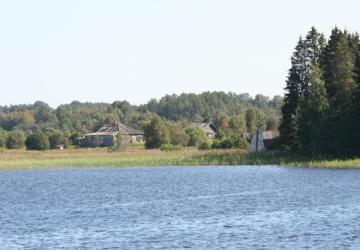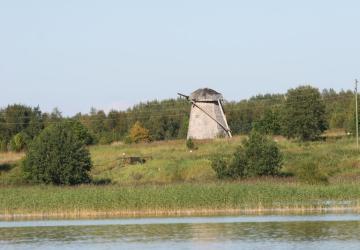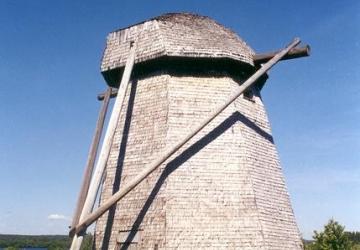
Seredka
Other names: Yakovlevskaya
First mentioned in 1563.
Number of farmsteads: 1 (1563), 8 (1678), 4 (1707), 14 (1911).
Seredka was a large settlement in the past but no ancient houses had been preserved. There is a mill standing on the edge of the village on a high open shore. The mill was transported from the village of Tolvuya. The appearance of the mill is unusual for the Kizhi neighborhood. The constructor, Pavel Konkov, used windmills of Baltics as a sample. That is why its appearance differs from the usual silhouettes of Kizhi mills. A log wall of a traditional mill was entirely mounted on a pillar dug into the ground and, as a result, the whole mill was turned to the wind. The difference of a mill from Tolvuya is that only the upper part of it (a tent top with wings) can be turned and a high octagonal tower remains fixed. It is also unusual that the mill is covered with lath. The occurrence of these structures shows that new influences started penetrating to the traditional architecture of the Russian North at the beginning of the XX century.
Seredka is a famous place. One of the Kizhi volost epic tales narrators, Leontiy Bogdanov, lived here. A clerk of the Olonets provincial office and a folklore gatherer, P. Rybnikov, happened to hear him singing. Rybnikov was struck by the unusual sound of ancient epic songs and went to Kizhi volost. Here he made a discovery that influenced all of the Russian culture in the future. He has found that not somewhere far away but right next to the Russian capital, St. Petersburg, there is a land where they sing epics and there is its own famous narrator in every village. It was believed by that time that nobody in Russia performed epic songs and that only text versions existed. Later famous scientists repeatedly came to villages of Kizhi volost to get acquainted with the unique phenomenon. The fame of Zaonezhie as of “Iceland of Russian epos” originates from this place.

